Rituals Roundup
This is my IndieWeb Carnival “roundup” post. I honestly didn’t know what to expect, as this was my first time hosting the Carnival. I’m amazed that 25 people read my topic and felt compelled enough to write something on their blog and send me a link. What an amazing thing it is to have this opportunity and to get to direct people’s minds to write on a topic. The results are below and I strongly encourage folks to click each submission and read it in its entirety. They’re all lovely and my notes are merely my attempt to shine light on what they struck in me. Thanks to all 25 of you that took time out of your lives to write the posts and the email that shared it with me.
Andrea’s Rituali
Andrea’s ritual of a couple’s massage with Noemi whenever traveling may be one of the best ideas I’ve ever heard for how to make experiences abroad even more soothing and relaxing. Chef’s kiss for this one.
Chris’s Rituals
Chris contrasting “working life” morning rituals with those that took hold once not working was fascinating. Once I’d read the post, I wondered what my “post-work” rituals will look like. Something tells me that my coffee ritual will persist, but so many other portions that are mere routine today could elevate to ritual status once time is less dictated by the corporate overlords.
Sara’s No Internet Ritual
When I first received Sara’s post, I didn’t immediately recognize that her referring to the ritual being “negative” meant a ritual of reduction or removal of something. Once I grasped that, I found this post fascinating. My wife recently discussed that we’re going to be doing “phone free weekends” from time to time with our entire family. I’m looking forward to it because I share some of Sara’s feelings from her “no internet” weekends. I hope she gets back on track with her rituals and they bring her the peace she seeks.
V.H.’s Assorted rituals
My favorite thing about V.H.’s post is the various angles of approach to the topic of rituals. That wasn’t merely my flight simulation pun, but a genuine appreciation for the underlying concept that rituals are about the process more than the output. In some cases, the only visible artifact of a ritual is the output, and therefore to another person’s eye, that’s all it represents. My kids see me drinking a cup of coffee and they say to themselves “Dad really likes drinking coffee,” but to understand the ritual is to understand the value of process.
Ken’s New family traditions
Ken took rituals in the direction of family traditions. I enjoyed the take and reading it makes me want to write about some of my family traditions growing up. I somehow differentiate rituals and traditions in my head, but I’m not sure how to articulate the difference.
Juhis’s Rituals build community camaraderie
Juhis nailed something so meta and ironic that I am a little ashamed of myself for not seeing it earlier. The IndieWeb Carnival is itself a ritual framework in many ways. I’m so glad someone pointed out what may have been so obvious to many of the other participants. I was also intrigued by the thought that “free thinkers” may push against rituals as they may feel limiting. I would define myself as such a thinker, but didn’t make that connection until Juhis highlighted it.
Manu’s Rituals
Manu was not the only person to refer to the Japanese tea ceremony this month. The mention of it has me not only wanting to learn more, but also makes my mind seek out other examples of ceremony that could serve as inspiration for how to hold a ritual in its highest regard. This could be in order to preserve it, or merely to further honor it beyond the simplistic term that it brings “joy.” I can also relate to the feeling Manu shares of feeling like life is a table ready to be flipped. Sometimes chaos leads to cleansing.
Chuck’s Rituals
Since Chuck’s ritual and mine both touch on coffee, I’ll share that I actually have a hand grinder ritual of my own. When we travel (just about anywhere), I bring my “kit”. I have a small hand grinder and an Aeropress for those brews. The feeling of the hand grinder is, I agree, meditative in its rhythmic processing of the beans.
Antonio’s Morning Coffee Ritual
Antonio’s morning ritual sounds luxurious to me. My ritual was based on making coffee but his is about experiencing coffee along with something mentally stimulating.
Bob’s Rituals
I respect both stances that Bob outlines. I think that his ritual of limiting variation in his life resonates with me as I’ve often wanted to create such boundaries for myself to simplify. I also like that he’d be open to a new ritual that looks to stretch himself, from time to time.
Jeremy’s A Dearth of Ritual
When it comes to the ritual of death, I agree that it is more for those left behind than for the person that has passed. That being said, I’d caution Jeremy to consider prescribing the rituals that are to be conducted. Not for himself, but as a final act to simplify the decisions they’re having to make in that hard moment.
Tracy’s Ritual Creation
Tracy’s submission was such a lovely way to remember someone who made an indelible mark on her life. After reading this, I feel a sense that the kids that got to be part of Coach Taylor’s rituals were overwhelmingly better for having the experience.
James’ Saturday morning reading
James hits so many great points in this post. His ritual is reading fiction, and this post highlights how he fell back in love with that act and then turned it into a ritual. I can relate as I’d loved reading as a child, but fell out of habit and last year started to read fiction at night as a way to “wind down” and it’s something I now look forward to throughout the day.
foreverlikethis’s VHS to Digital
What a trip down memory lane this post was for me. Not because my family has a vault of memories locked away in some form of media. My mom and dad never made home movies or recordings. We were a 35mm camera clan and so my memories of VHS centers around two realms. Taping of and then re-watching an uncomfortable number of times to admin the show C.H.I.P.S. is the first. The second is my 2 years of employment at Blockbuster Video during the end of the VHS era. DVDs took up only one aisle in our store, but the end came quickly after I left the gig.
Lindsey’s Rituals
I’m so glad Lindsey participated in the Carnival for the first time during this month. The phrasing of “there are no neutral practices” really hits for me. This is a phrase I couldn’t have put my finger on when coming up with this topic nor when I wrote my own. It’s the compliment to the statement around intentionality. Seeing so many mentions of religious context and then an expanded concept of rituals from this exercise has also been a joy for me.
Martín’s Rituals
Martín touches on something I’d not thought of when mulling over rituals as a topic. I definitely thought of the corporate project management connotations of “rituals”, but never the very clear connection to the world of sport. There are so many fascinating examples of rituals that teams or individual players/athletes perform. Sometimes they are rituals of luck and other times they are simply the rituals that set forth the mentality to achieve (in this case, to win).
Soren’s Rituals
Great to see another blogger jumping into the Carnival mix during my month! Soren’s researching of those terms feels very familiar. I will admit that it wasn’t a topic that I landed on easily for my hosting duties, but posts like this one have made me so glad that it was not only well received by the community, but so many amazing posts have come from it.
Marisabel’s Rituals: then & now
Parenting is hard. Like really hard, sometimes. I love that where Marisabel has landed is such a pure distillation of why being a parent, for me, has been the single most rewarding thing I’ve done with my life. I feel like printing her ritual quotable on cards and handing them without judgement to all the parents I see at events with their kids, yet mindlessly scrolling on their phones while they are missing out on something they can never get back.
Mel’s Rituals
One of my favorite parts of the IndieWeb Carnival is that it shines light on parts of this world I knew little to nothing about. I had to do a bit of research just to be able to come back and understand Mel’s post. Finding rituals that connect to importance in your life seems like a win for all involved.
Barry’s Routine
It is ironic that Barry talked about the “typical” version of parents wishing their kids would return to school. I was just talking to someone at work and telling them that I missed my kids being home and I was dreading the return of school. That routine is much less zen for our household, but it is a necessary evil. I can’t wait for them to be back home when I come out of my office during breaks.
Dario’s Rituals
Dario speaks of rituals and ceremonies relating to Scrum project management methodology. I thought of this when I picked this theme, because I often hear the terms used in that context at my day job. I agree with the concept that these are examples of “illusions of control.”
Paolo’s Lack of Rituals
Rituals may not be for everyone and this post by Paolo distills that nicely. I would, maybe, are that Paolo has a ritual of reduction that is thinly masked as habits or previous rituals falling away. It is beautiful in a way because as we have things we do regularly that no longer fit our lives, it is like trimming away branches that no longer need to be on a tree and pruning them away leaves the tree free to grow further in another direction.
Britt’s Rituals
When reading Britt’s post, I came away realizing that our similar ritual of preparing tea or coffee is almost equivalent to a breath. I never would have seen the analogy so clearly had it not been for this lovely submission.
Rees’s Rituals
I’m so glad that Rees decided to start submitting to the Carnival this month! A word that has come up in several submissions is intension. Choosing to derive things in life that are worth designing rituals around by looking through the lens of intentionality is great.
Zinzy’s Rituals
Zinzy nails a feeling I struggle to write about. The feelings of failure from rituals you wish you could break. She also really challenged me to think about how easy it is to hold up the “golden rule” when thinking about how you treat others and how you’d encourage them to treat you, but we rarely hold ourselves accountable to the same standard in how we treat ourselves.
Carl’s Rituals
Carl’s description of savoring that first sip of coffee sounds so familiar to me. The smell and the warmth plus the taste all create a symphony of experience.
Don’s Rituals
Don accidentally wrote about the rituals theme a year late, but I wanted to include it in the round up since you never know when someone may land here and get to read his submission because of it.
PenPals With Jarrod Blundy
Jarrod Blundy writes over at his blog HeyDingus. I got on with Jarrod from our very first interaction. The name of his blog immediately resonated with me from my many hours listening to Merlin Mann’s podcasts. Jarrod’s posts are interesting and span a wide variety of topics.
Jarrod mentioned to me that he had been running a monthly PenPals series where he and another person he’d met on the internet would email back and forth about whatever was on their mind and then he’d post the full conversation on his blog for folks to read once the month concluded. I thought it was an awesome idea and was happy to participated.
Here’s the link on Jarrod’s site to the full exchange. He formats it so nicely, I’d prefer people read it over there than embedding it here.
Jarrod, if you’re reading this post, thanks man. It was my honor to be your July PenPal.
Raindrop No More
Almost out of nowhere, I decided to delete my Raindrop.io account today. It had something like 250 bookmarks in it, but I hadn’t used the service in quite some time to save anything new. I’d moved from Pinboard to Raindrop.io years ago. Both services are great for saving bookmarks and have similar feature sets when it comes to folders, tags, etc.
The reason I deleted the Raindrop.io account is that bookmarking as a service just no longer fits my mental model. The way I approach this now is that if it is something I want to read, I save it to Matter (my read-later app of choice). Once I read something there, I archive it. I don’t go back to those bookmarks, almost ever. What I recognized about myself is that having a huge collection of bookmarks is just giving me more to have to organize and manage. I rarely ever went back to Raindrop.io. It was like a graveyard of links I’d never do anything with, yet I’d tag them and put them into categories. Raindrop.io is a great app for those that manage their bookmarks in a robust way. It just wasn’t for me anymore.
For anything that I truly believe I’ll come back to, I save it to mymind. I use mymind for more than bookmarks. It has become my private vault of sorts, for pictures, links, color palettes, inspiration, mood boards, books, movies, and much more. I’m going to write a post about why I’ve moved in this direction, but for today, realizing I no longer needed Raindrop.io was a nice feeling since that digital clutter has now been removed.
A Short Guide to Dealing with Discouragement
I really enjoyed this piece from Leo Babauta.
…discouragement isn’t a problem.
It’s a property of learning, of growth, of trying. Just like heat is a property of the sun or fire. Discouragement is a property of caring and having hope.
I often frame a similar thought starting with discomfort. I love the perspective that discouragement and caring or hope are flip sides of the same coin.
Rituals
This post is my entry for August’s IndieWeb Carnival being hosted by the person typing these words.
I’m a systematic thinker. I have many processes and frameworks for how I approach life. Those frameworks have modules and the processes follow a routine. All of those repeatable action sequences accomplish tasks and make my life stable and consistent where it adds value. None of those things are rituals. I have few rituals, and I’m writing about just one of them today; coffee.
Coffee has been part of my life since I was a kid. I’d drink it in the mornings that I’d tag along with my dad to work (which was often). I’d drink it throughout college and into the workforce. Furthermore, I have always had an appreciation for coffee as a beverage that was stronger than most. This all predates the “coffee craze” once there was a Starbucks on every corner and now tons of competing coffee brands springing up to give that Seattle Siren a run for her buckets of money. Coffee did not become a ritual for me until about 15 years ago. That’s when I started to educate myself on bean quality, freshness, variety and the various methods of grinding and brewing. That’s when coffee consumption went from good to out-fucking-standing for me, and when coffee itself went from the scale of love interest to passionate soulmate.
I took a pause in writing this post at this moment to go make a cup.
As rituals go, the steps are simple for mine. They can be summarized as follows:
- Weigh coffee beans.
- Grind coffee beans.
- Pour hot water on ground coffee beans.
- Enjoy drinking delicious coffee.
I’ve detailed the tools I use for this ritual on my Uses page, but that’s not the point of this post. What makes this ritual special and worthy of ritual status isn’t how simple the process can be written. The ritual is about the feelings that the process evokes as it is executed. I use a scale to weigh the beans, but I can normally nail the 20g mark by eyeballing the beans before seeing the reading. I can see if the grind is too fine or coarse based on how the water flows through the bed to the bottom of the V60 and into the cup. For me, making a cup of coffee has evolved from a set of actions to support the enjoyment of drinking it to a ritual that brings enjoyment at every moment in the experience.
Someone pointed out to me that what makes this ritual enjoyable is the little bits of control that are represented throughout. I do tend to agree that my mind does enjoy the structure and the control, however, it isn’t the sole reason. The aroma of the coffee during each phase of production. The sounds of the grinder completing its task. The satisfying landing of the grounds in the cone filter. The beauty in the bloom of that first pour. The slow and sultry retreat of the water as it recedes to reveal the grounds once again between pours. The heat against my face as I take the first sip. It’s all of it. It brings a calm and happiness to my mind and my soul that I can’t imagine being as complete if I weren’t invested in the process. I rarely get coffee while out of the house these days because it feels like a degraded experience. It checks the box for the nostalgia of a truck stop or restaurant cup of coffee, but it lacks the richness of my ritual.
Making a cup of coffee is the ritual that grounds me (pun intended).
Macropad Project
This was a fun one. I’ve wanted to get a macropad for some time now. If you aren’t familiar with macropads, they are simply a small standalone keyboard, sometimes with a knob as an additional control type. I didn’t like most of the cheap products I saw on Amazon, but I also wasn’t looking to spend on the high end for it either. I wanted it to blend aesthetically with my mechanical keyboard and I wanted it to have customizable switches and keycaps so that I could push the style integration to its maximum. There’s also a bit of software called VIA, and compatibility with it was a must as well. This is what allows you to easily program the buttons, knobs and combination of the two however you’d like to perform keyboard shortcuts, recorded key macros, and more (hence the “marco” in macropad).
I’d been looking for some time, and one night was wandering around a combination of subreddits and Google when my search strings brought back the Momokai website. Specifically, a product page for the Aurora macropad from Momokai. I’d never heard of Momokai, but damned if they didn’t make a reasonably priced product that checked every one of my boxes and then some. This thing looked to have build quality way above what I’d been seeing in the same budget. It was an all aluminum design, and I could see from the images online that it disassembled very easily for customization. It only came in anodized black aluminum, but I’ve painted metal parts for other projects, and I knew I could make this thing look perfect for my desk setup.
I ordered it, and then got to work. I did several coats of paint on the parts to carefully bring it from stock black to a matte white that looks perfect next to the keyboard. Using left over keycaps from my mechanical keyboard set makes it look like it belongs right next to it. Here are a few images of the product as it is out of the box, and then my customized beauty:
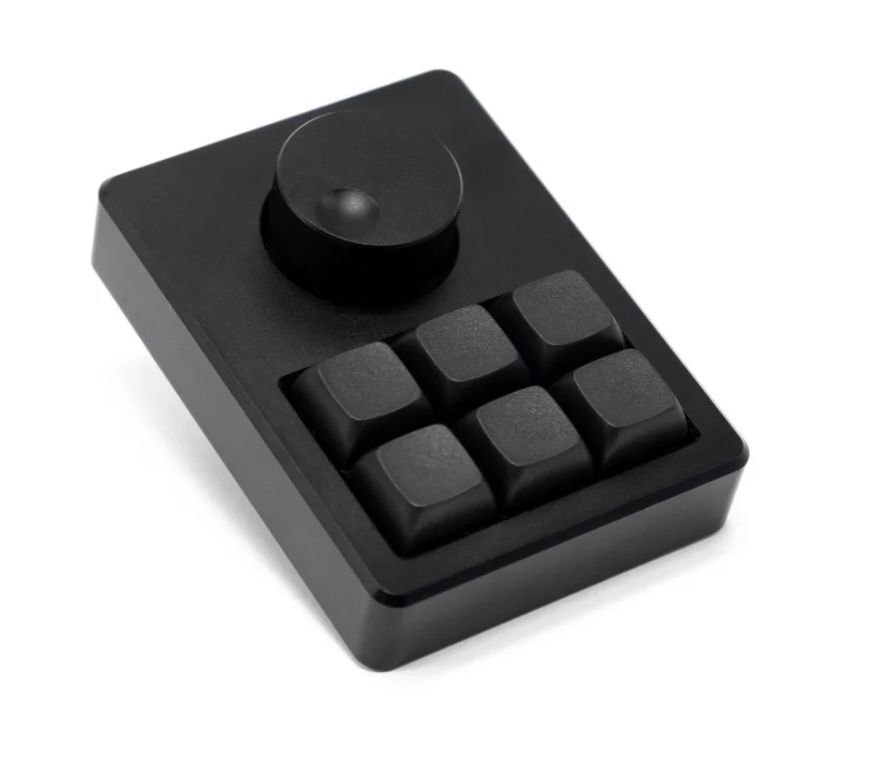 Aurora macropad as Momokai designed it.
Aurora macropad as Momokai designed it.
![Aurora macropad [LDLW Edition] - View 1](https://cdn.blot.im/blog_60118cb29b7a4a229ffbfd98b46953e8/_image_cache/c18581ba-e8dd-4caa-b2e0-7befd5646962.jpg) Aurora macropad [LDLW Edition] - View 1
Aurora macropad [LDLW Edition] - View 1
![Aurora macropad [LDLW Edition] - View 2](https://cdn.blot.im/blog_60118cb29b7a4a229ffbfd98b46953e8/_image_cache/1a5d1e91-2b65-4794-91ca-d2fda78aa981.jpg) Aurora macropad [LDLW Edition] - View 2
Aurora macropad [LDLW Edition] - View 2
I’ve only just started to program the keys with shortcuts and macros. I want to do this slowly so that I build the muscle memory and make it a true productivity gain vs. just a fun little geek project. My first macro is a simple, but often used one. When I press #1, the macro executes keyboard shortcuts with millisecond pauses where needed to achieve the following workflow:
- Bring Microsoft Teams to front most focus.
- Toggle to the Chats pane of Teams.
- Start a new chat.
- Put the keyboard cursor focus in the Contact box for the chat.
That’s it. Once these steps happen in a matter of a second or two, no matter where I was on my computer, I’m now typing the name of the person I need to chat with and either starting a new chat or bringing up the existing chat thread. I use this many times a day in my work. It saves me both keystrokes and from getting distracted along the way. Sometimes my Cmd+Tab to Teams would land me in another channel or conversation that would take my focus away from chatting with the contact I need to talk to now for the task at hand.
Fido & redirect.pizza
I enjoy finding a tool that solves a very specific problem well. I had that experience twice this week and I wanted to share them since the problems they solve are common to those in the indie web community.
Fido
Fido is a tool developed by Meadowing. It finds broken links on your site. It couldn’t be more simple. You plug in your URL and it scans the whole thing and then comes back with an index of the links that don’t work. When I ran Fido for my site, it found 3 links that were mistyped. Those are now fixed and it was such a simple task thanks to Fido. I found it after seeing another blog that used Meadowing’s lovely Guestbooks solution.
redirect.pizza
Fun name; great tool. redirect.pizza solves a very niche problem when dealing with sites. Most domain name services (like Hover or Porkbun) offer a redirect function. The issue I was running into was that I’d merged two of my old blogs into this one. Hover’s redirects for the two old domains worked, but not for https routes. With most modern browsers defaulting to https (for good reason), this meant that when someone just typed techandcoffee.com into a Safari address bar, it would render a 404 page error. My wife was the one that brought this up to me (thank you). While I knew the technical reason for the negative experience, I hadn’t put the time into finding the right solution.
Rather than having to setup landing pages to point people to Tangible Life, or configuring SSL certs redirects (which wasn’t an option since the old sites are no longer sites, and just domains I still have registered), redirect.pizza’s free tier offers 5 domain forwards that include handling of https routing. It was 5 minutes of configuration between redirects.pizza and Hover and all versions of my previous two sites route here. It even supports forwarding to the same path endpoint (which I didn’t need) and has a toggle for tracking hits or letting it be a completely private implementation (which I opted for the latter).
When I find these little gems, I’m going to collect them into small posts like this one. Simple tools for common problems. Great stuff.
IndieWeb Carnival: Rituals
As July wraps up, I’m excited to be hosting next month’s IndieWeb Carnival! The topic will be rituals. It is purposely a very open theme and I can’t wait to read what people care to share.
A few prompts to inspire, but feel free to come at it from any angle at all:
- What value do rituals possess in your life?
- How have rituals shaped you?
- Are there any rituals you’ve outgrown and left behind?
- Does the term “ritual” carry any negative connotation when you hear it?
I’ll post my own entry sometime in early August and will include submissions sent through September 1st. I don’t use webmentions or current day social media platforms, so please send me the links to your posts via email. Once the month comes to a close, I’ll do a roundup post of submissions and the thoughts they sparked for me personally.
Also, please spread the word about the IndieWeb Carnival and grab a future spot to host if you’re inclined.
June Travels
In June, I took three trips. First to Cocoa Beach with the family after dance recital weekend, then a one-day trip to St. Louis for work and last my wife and I had a getaway for the last couple of days of June. It was wonderful to spend time just the two of us. As parents of a large family, we rarely get that opportunity. We stayed in St. Augustine and ventured down to Marineland Beach, which we’d never visited before. It’s a beautiful beach and is unique due to the rock features along the shore. Cocoa Beach, our default family beach trip destination, is completely different even though it’s just down the Florida east coast from Marineland.
While I only posted to the blog once in June, all of this time away from home and my daily routines offered a lot of deep thought time. Those thinking sessions fuel future writing sessions, so I’m grateful to have had the time and opportunity to have them.
Here’s a few photos from the three trips:
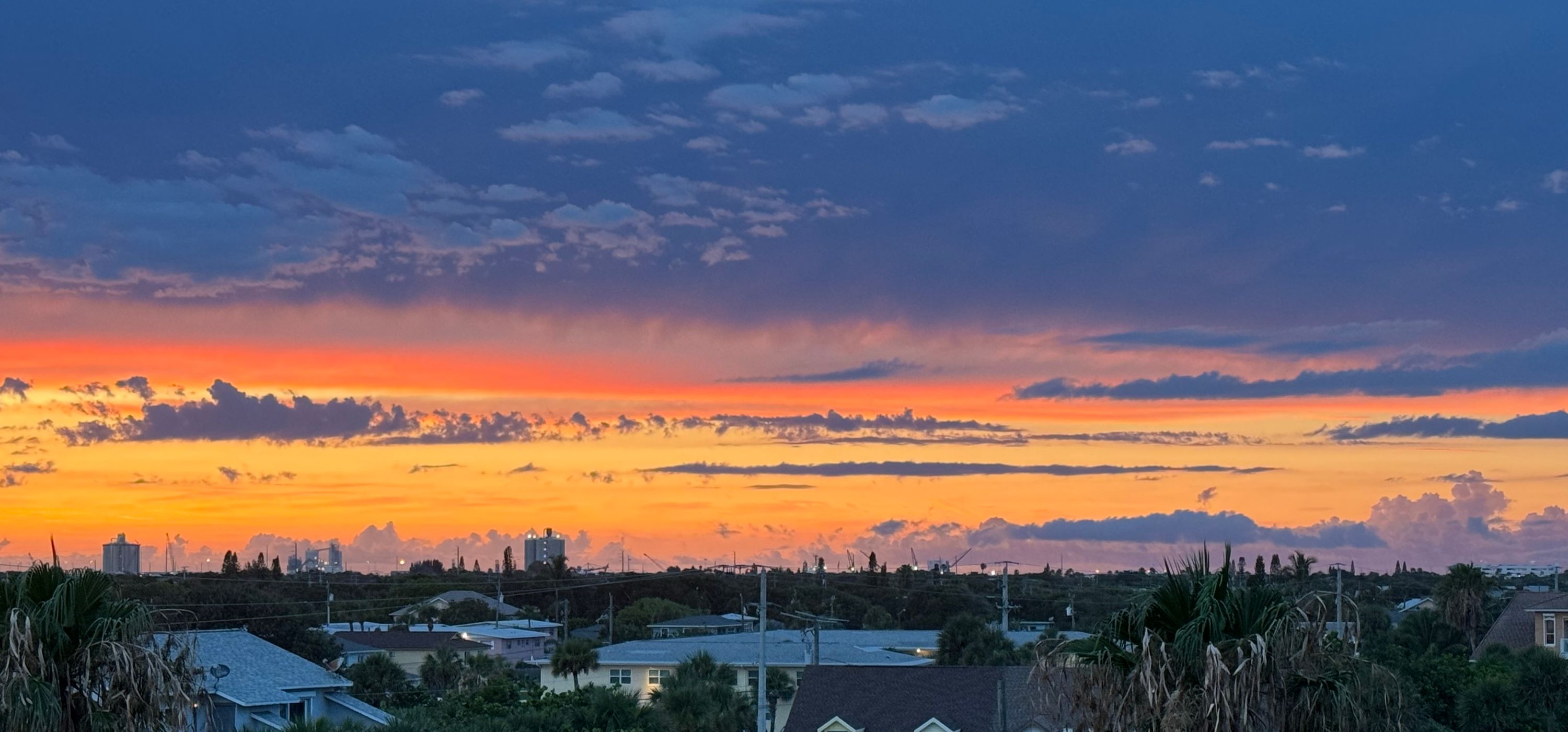 Cocoa Beach sunset.
Cocoa Beach sunset.
 Evening take off from St. Louis.
Evening take off from St. Louis.
 Nightfall was gorgeous on this flight.
Nightfall was gorgeous on this flight.
 Marineland beach.
Marineland beach.
Tools
This post is my entry for July’s IndieWeb Carnival being hosted by James.
I’ve written about tools many times on this site. I have an entire Uses page that lists many of the tools I own and use for various things. In the purest sense, a tool is nothing more than something that aids in doing something. A spoon is a tool. A pen is a tool. The M2 MacBook Air I’m using to create this post is a tool.
The tools that mean the most to me, though, aren’t the tools I tend to have written about to date. They should be, given the name and goal of the site, but until this thought provoking carnival theme, the idea hadn’t struck me that they’re more than deserving of being written about. The tools I’m speaking of are hand tools that have been passed down to me by my dad. They each have unique and rich lineage. Some were passed down to him by elder family members. Some were found. Others were purchased by him when tools were made well enough to outlive their owners.
One of the best examples of these tools is a pair of linesman pliers. I don’t recall which family member gave him these, but many years ago, they became mine. We were doing a job together and when the job was done, my dad and I were sorting and packing up our respective tools to go back to their respective toolboxes. I picked them up and attempted to hand them to him, and that’s when the transfer initiated. He looked at them, and as he does, said something like, “Do you know where those came from?” Even if he’d told me more than once, I likely didn’t remember or I just wanted to hear it again. I may have offered some tidbit of info like a name of someone I know gave him things of the sort. He grabbed them and gave me the history once again. He told me jobs they’d been used for that I had experienced the end product or result. He would hand them back to me and they’d feel heavier than when they were in my hand minutes before, with the added weight of significance they possess beyond physical grams.
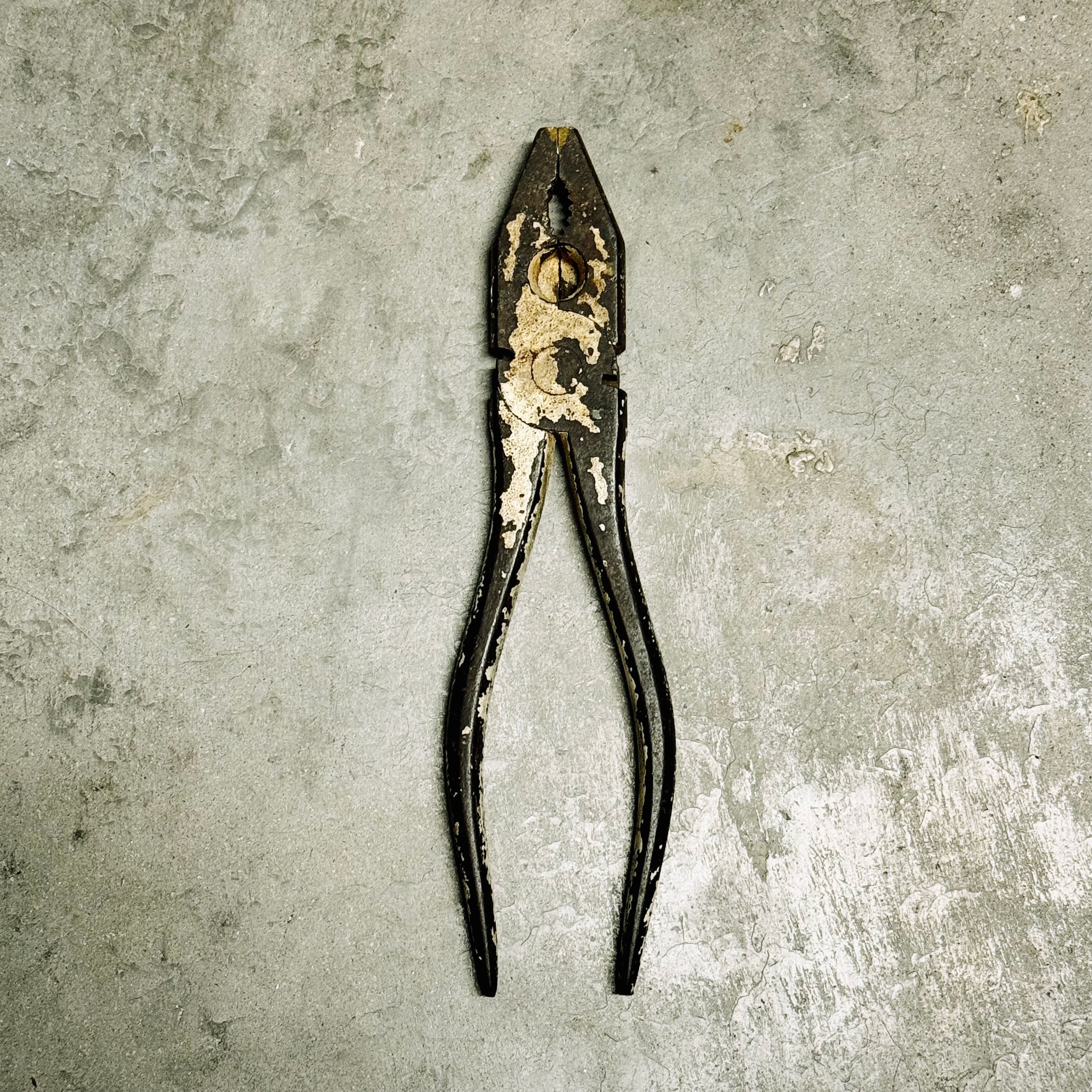 Linesman pliers that were built to last.
Linesman pliers that were built to last.
He looked at them, and then at me and said, “You keep ’em. I’ve gotten my use out of them and you’ve got a lot of jobs ahead of you.” I’m almost certain that, without fail, I’d always respond to a magical tool transfer moment like this with, “Are you sure? I know they mean a lot to you.” Never a man to dwell in the sentimental, he’d respond, “If you want them, have them. If not, I’ll hold on to them.” Seconds would pass, and then he’d add, “Until I die. Then you and your brother can fight over them.” I took the pliers and added them to my inventory. Each time I go into my toolbox and grab them, I know they’ll get the job done. I can’t wait to pass them down to one of my own kids, sharing the history and references to jobs I’ve done with them that they’ll have a connection to.
I’m on the verge of both tears and laughter writing these words. Things my dad has said to me over my lifetime are very much like those linesman pliers. They’ve done the job they needed to do. They also land heavier now than they did when he said them to me then. He’s at a later stage of his life and while the lineage of those tools can be recalled and retold as many times as necessary, newer details and stories just don’t stick. While it’s all part of the journey of life, it’s difficult to not have the tools to hand him as he’s always had it to hand to me.
Something From (Almost) Nothing
This post is my entry for June’s IndieWeb Carnival being hosted by Andrei.
First of all, what a great theme for the IndieWeb Carnival. I can’t wait to see what others share, because there is something truly inspiring about seeing what others have made or repurposed.
Part of me wishes that my NO SOLICITING sign build had wrapped a couple of weeks later, because it’s likely the purest form of Andrei’s theme. My latest project falls into repurpose and customization, but the (Almost) addendum to the writing theme highlights how making customizations yourself is the best way to achieve what you want from a product. This pushes against the buy/return (or throw out) cycle that many consumers follow as a default, wasteful consumption pattern today. The project is in its final stage and will be wrapped up within a week.
We’ve lived in our current home for 7 years this July. When we moved in, we bought a Hunter Cranbrook ceiling fan in the mint color. I fell in love with the mid-century modern design the moment I saw it. The fan has served as a conversation piece in our family room. Whether walking in from the garage (our primary point of entry), or walking in from the front hallway, the design grabs the eye. Recently, we’ve refreshed our kitchen/family room with new light fixtures and furniture. It was time for a change (mostly due to our English Mastiff being past the chewing/puppy phase) and we’ve been happy with the changes made. The mint/walnut combo was no longer in harmony with the new palette, but we couldn’t part with this gorgeous fan. Rather than repurchase the fan in the “dove gray” option, I told my wife we could do a better job of customizing it. The blades would have still been light pine or walnut, and that wasn’t quite right.
I’d installed the fan 7 years ago, so I had some memory of how it came apart. I took the fan down and disassembled all the parts that would allow me to paint the metal mint components. Luckily, all the mint parts could be completely removed from other non-mint parts, so no masking was necessary. This considerably sped things up for the paint process. I took each component outside and completed 3–4 coats on each item, being careful to make sure every visible surface got coverage. I placed the items in used shoeboxes to keep any dust or insects from landing in the paint as it was drying. The parts look amazing, and I’ve reassembled what I can up to this point. Next came the blades.
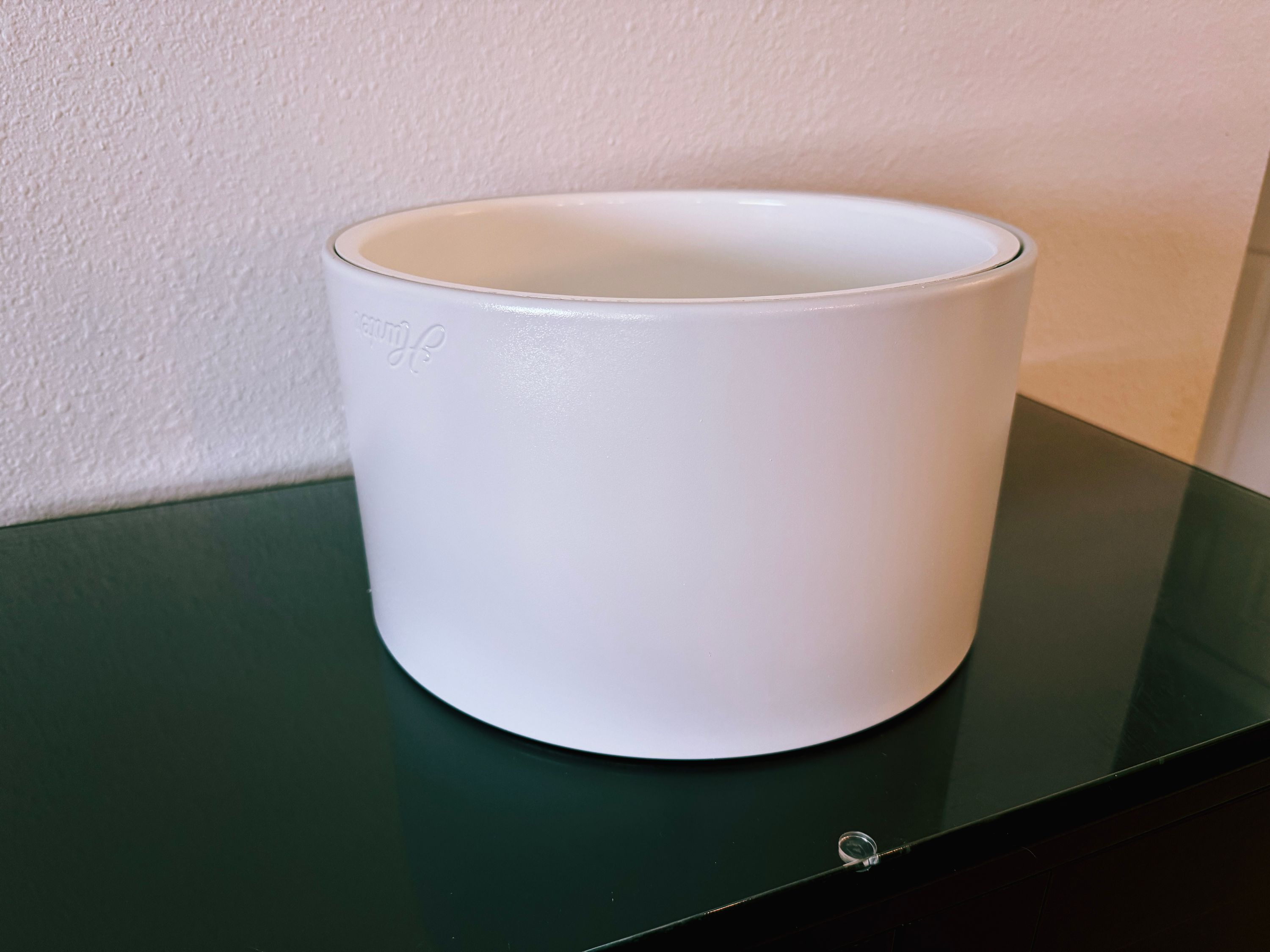 Hunter Cranbrook hood painted gray
Hunter Cranbrook hood painted gray
We needed to do some touch-ups on our kitchen cabinets as part of the rejuvenation of the space, so I decided we’d stain the fan blades to match the semi-gloss, dark espresso color and finish of the cabinets and paint the mint portions of the fan a similar gray to the variant Hunter sells, but even more perfect for our palette. My first attempt at getting the stain resulted in a color way too close to black, vs. the deep raisin and plum tones in the cabinet finish. A much more artistic paint store employee and I spent 35 minutes tweaking and reviewing a custom mix of black stain with magenta and purple tinting until it was just right. I’ve completed one blade as the test, and the remaining three are all that’s left to complete the customizations, so I can re-assemble.
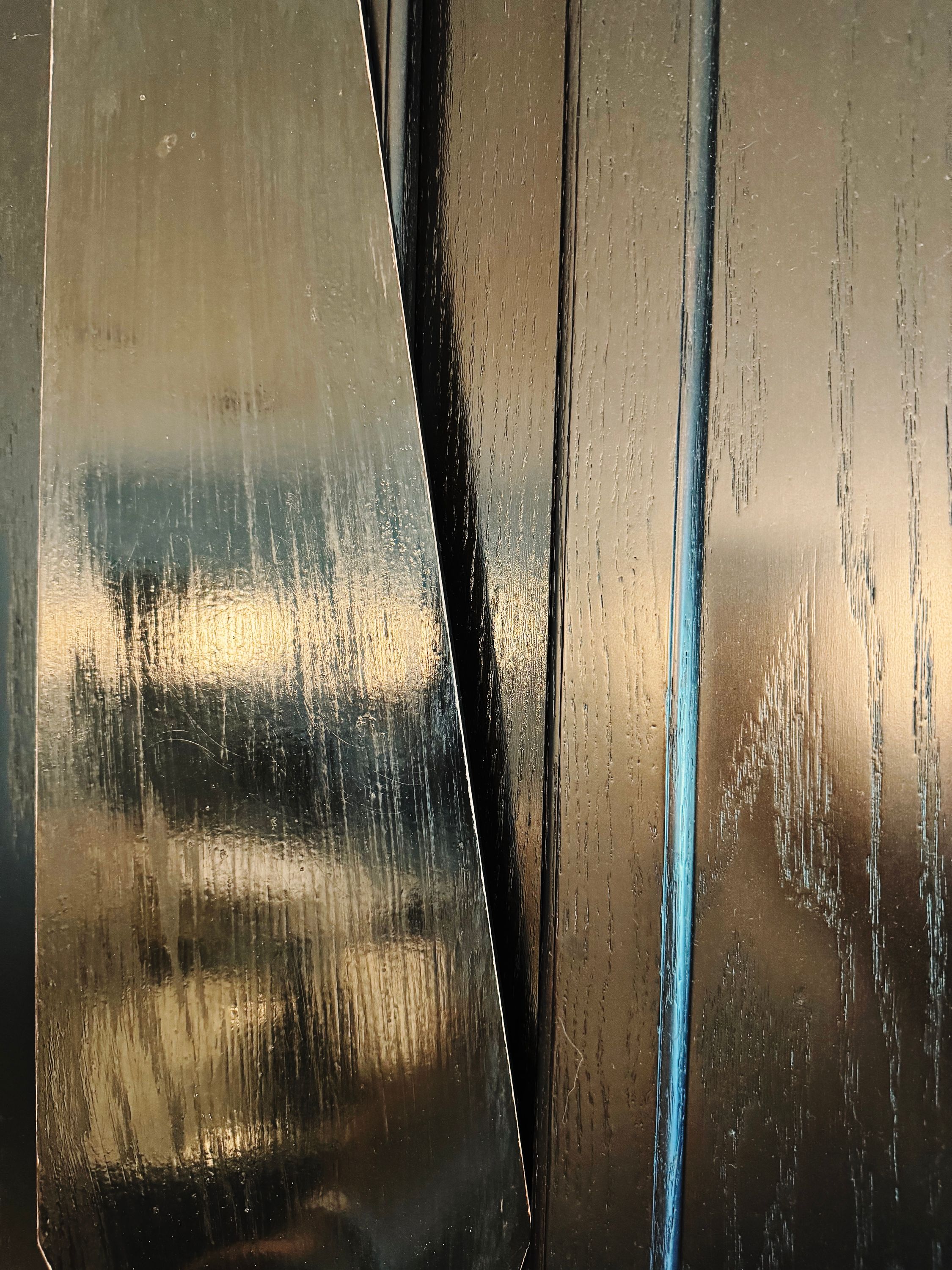 Fan blade & kitchen cabinet comparison
Fan blade & kitchen cabinet comparison
The best thing about a project like this is that the fan I already loved looking at and enjoying will now be something I can appreciate no only the designer that created it, but the adaptations made to it with my own hands. Next time you think you have to buy something new, evaluate if there’s something that you can repurpose or enhance instead. The result is so much more fulfilling.
Update: Here’s the final product.
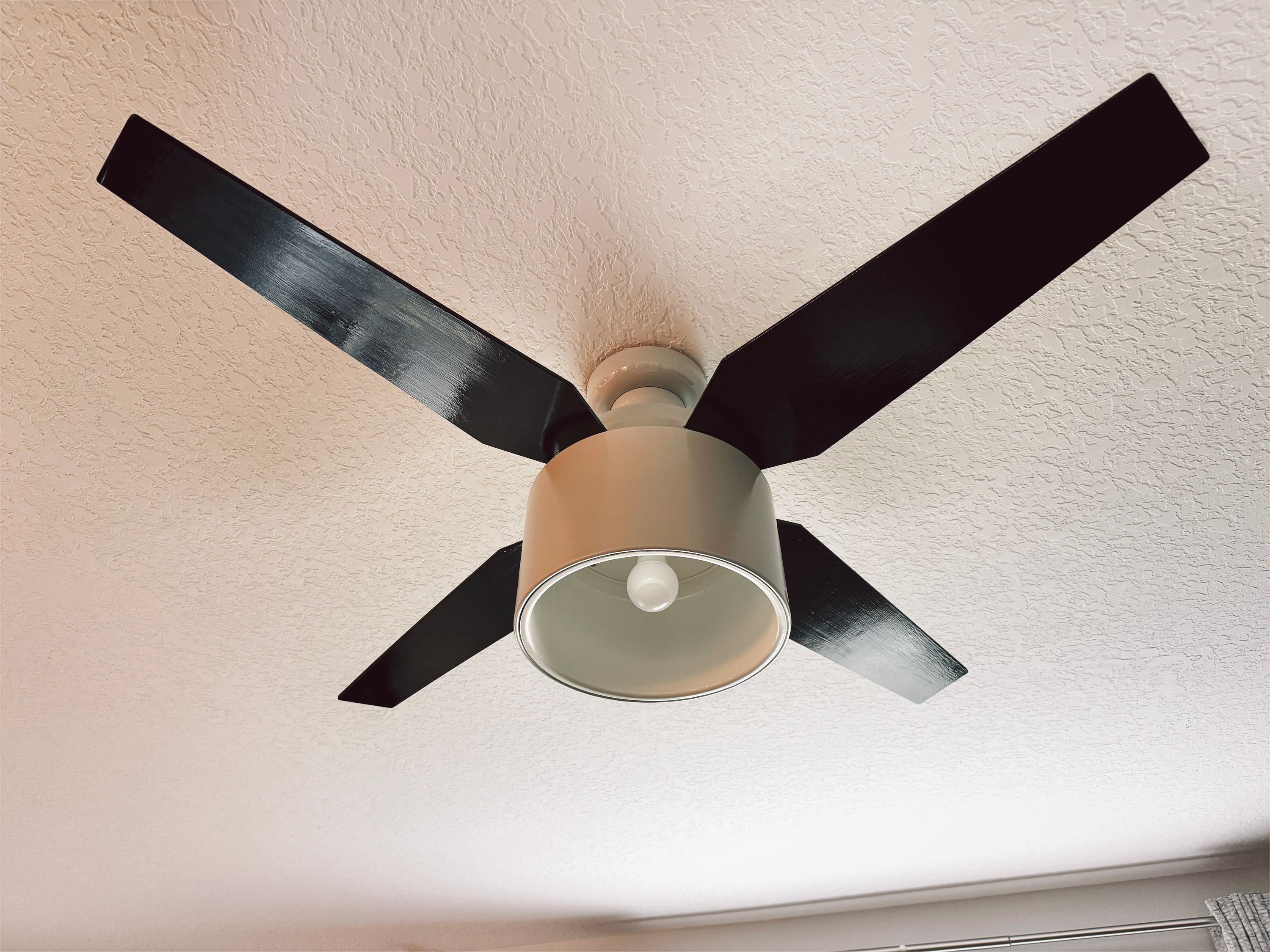 Customized Hunter Cranbrook
Customized Hunter Cranbrook
My Blogging Workflow
Much like the cycle of app defaults posts, I’ve landed on another interesting round of posts from bloggers about how they blog. Thanks to Manu for bringing me into the fold with his post, and to Robert for starting the fun and linking to the posts around the web.
I keep a Markdown file of things I’d like to write about someday. That list varies from just loose ideas in a few words to something more thought out if I don’t want to lose the details if it’s something I’ve given more thought to. Occasionally, I’ll add bits to existing ideas, but most of the time the way they go in is the way they stay until I write out a post.
I have a couple of Shortcuts that I’ll use to start a post off to make the YAML frontmatter and template easier. That goes into a folder in iA Writer called drafts. I’d consider a draft to be anything partially written and not scheduled for posting at a future date. I will occasionally write something and have it go out in a few days or weeks. This is because sometimes my writing comes in bursts, but I’d like my RSS feed to be slower for readers. Most posts started in this way get finished in one sitting. Occasionally, it will take time. I don’t feel a pressure either way. When the post is done, I use the LanguageTool grammar checker and then paste it back into iA Writer, update the YAML values and move it to the Posts folder.
The only deviation to the above is linkposts. I don’t post them as much as I used to, but the workflow is similar. I use a different shortcut that formats things specific to my linkpost template. I used to sync my highlights from my read-later app of choice, Matter, to Notion where I’d categorize which site I wanted to use for the linkpost. That workflow went away when I merged all my sites into Tangible Life, and I’m glad it’s more simple now. I’ll tag things in Matter that I may want to use for a linkpost or a newsletter in the future, but most of the time I just create the linkpost at the time I’m consuming whatever it is and post it.
I’ve been reading up on webmentions recently. I am not sure whether they’d completely replace my linkposts, but I’m considering implementing them in the future.
…and those are my flows! Reach out if you have any questions about my workflows.
Creative Environments
This post is my entry for May’s IndieWeb Carnival being hosted by Juha-Matti Santala.
I used to be precious about these things, long ago. Now, most of my posts get written with my laptop at the kitchen counter. I will sometimes have an idea strike me while I’m making lunches for my kids before school. I’ll walk over, open the laptop and jot a few things down to come back to whenever I get the opportunity. The ability to have what feels like an almost endless battery on the M2 MacBook Air (plus the instant wake and login of Touch ID) removes whatever friction would have existed with this in the past.
There are times when I have an idea framed, but really need some solid quiet writing time. I will usually sit on my front or back porch for these longer sessions. If it’s too hot for that, the Eames Lounger in my home office is a great spot too. Because I use my standing desk for the work that pays my bills, it doesn’t often feel like a creative environment in the sense of my writing. I will sometimes noodle around with something there, or tinker with something that the desk surface is really best suited for. An example of this type of creation would be my recent no soliciting sign build.
Only when I’m doing graphical design tasks do I plug my personal laptop into the Thunderbolt dock at my desk to take advantage of the larger screen. I also have an 11” iPad Pro (2018 model) and Magic Keyboard that I’ll take on the go for writing in random locations. I’ve written posts while waiting in carline for my kids to get out of school. In waiting rooms of various flavors and so many other places I can’t recall at this moment.
In the end, all I really need is a good idea and the creative environment will sort itself out. There’s always the dream of a perfect zen spot next to a rock pond or babbling stream, but if those were the only places I could write, you wouldn’t be reading this post.
Stand for Something
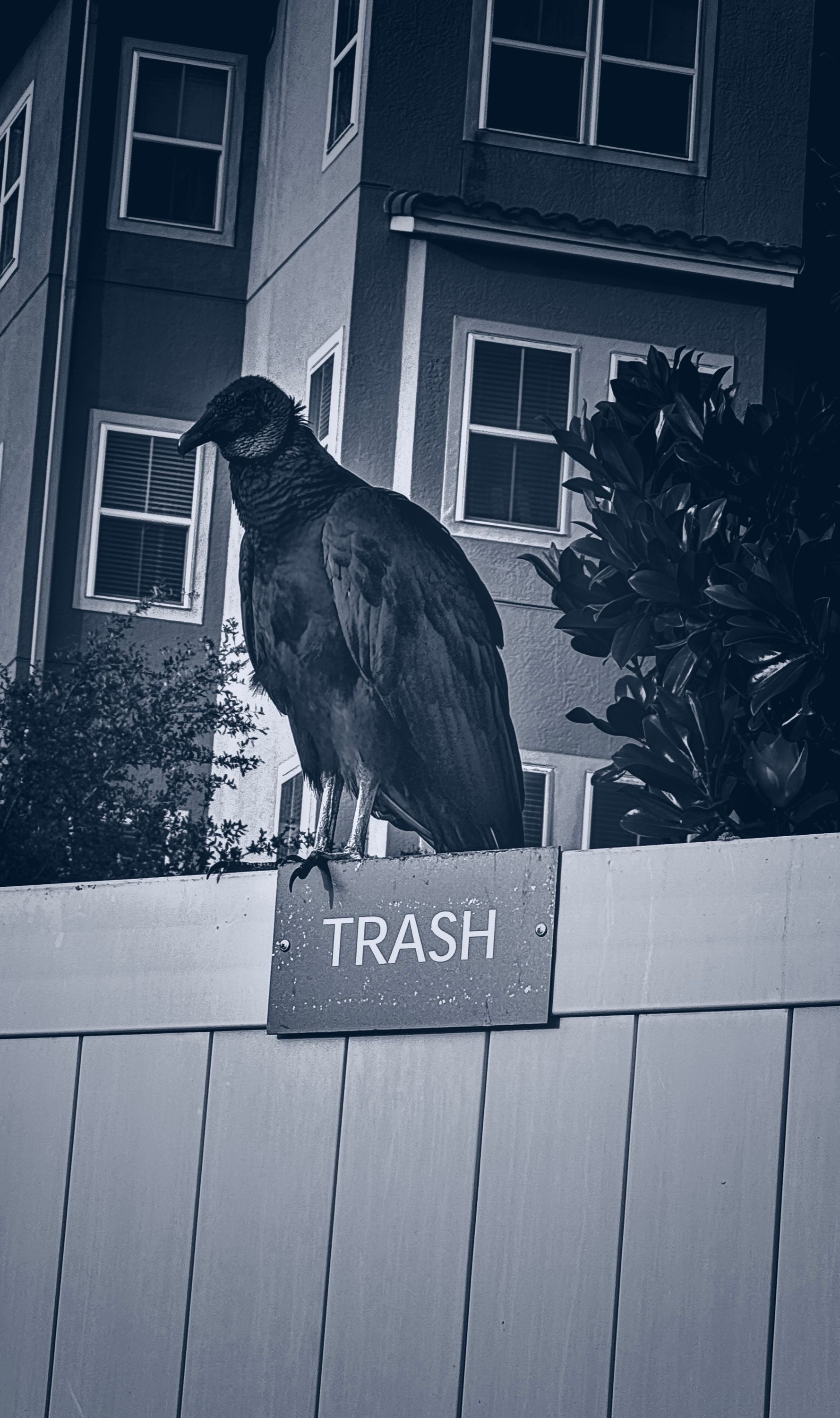 Vulure; standing on business.
Vulure; standing on business.
I took this picture this morning. To me, it represents the epitome of owning your brand. Stand for something in this world. Even if your brand isn’t the brand that others might find attractive or sexy or trendy; fuck all that shit. Master the subtle art Mark Manson popularized with his book title.
Be you. Unapologetically.